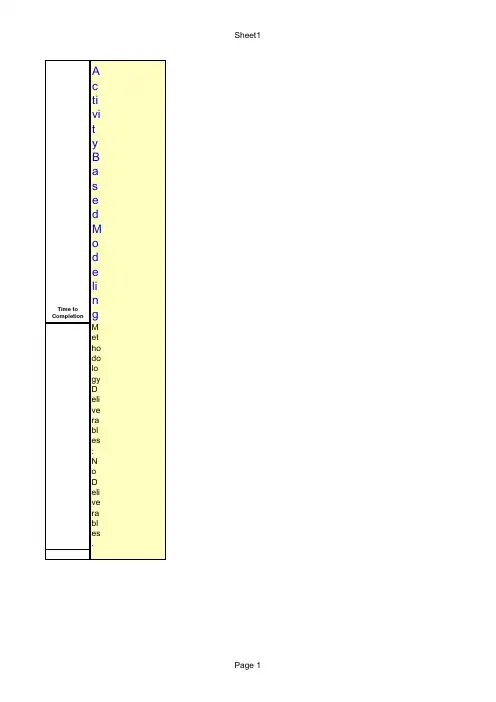安达信咨询方法与工具资料库TRANACT
- 格式:xls
- 大小:290.50 KB
- 文档页数:34
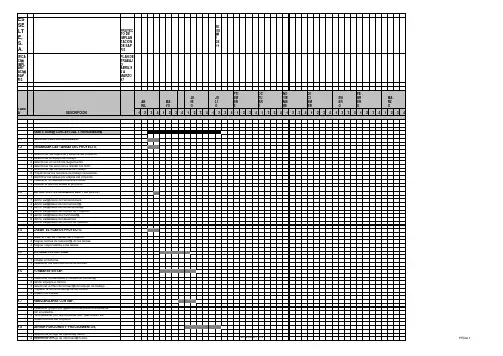

精品文档,值得拥有1. Managing Endings: A ChecklistYes No____ ____ Have I studied the change carefully and identified who is likely to losewhat—including what I myself am likely to lose?____ ____ Do I understand the subjective realities of these losses to the people who experience them, even when they seem like overreaction to me?____ ____ Have I acknowledged these losses with sympathy?____ ____ Have I permitted people to grieve and publicly expressed my own senseof loss?____ ____ Have I permitted people to grieve and publicly expressed my own senseof loss?____ ____ Have I found ways to compensate people for their losses?____ ____ Am I giving people accurate information and doing it again and again? ____ ____ Have I defined clearly what is over and what isn't?____ ____ Have I found ways to "mark the ending"?____ ____ Am I being careful not to denigrate the past but, when possible, to findways to honor it?____ ____ Have I made a plan for giving people a piece of the past to take withthem?____ ____ Have I made it clear how the ending we are making is necessary toprotect the continuity of the organization or conditions on which theorganization depends?____ ____ Is the ending we are making big enough to get the job done in one step? Final Questions:What actions can you take to help people deal more successfully with the endings that are takingplace in your organization? What can you do today to get started on this aspect of transition management?1 / 1。
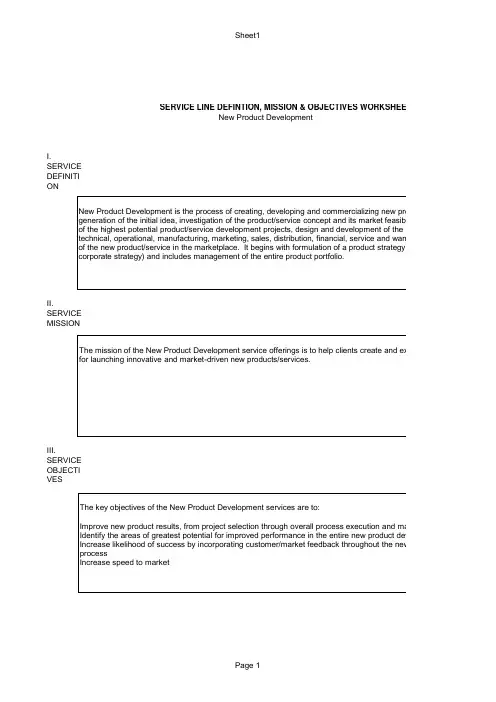
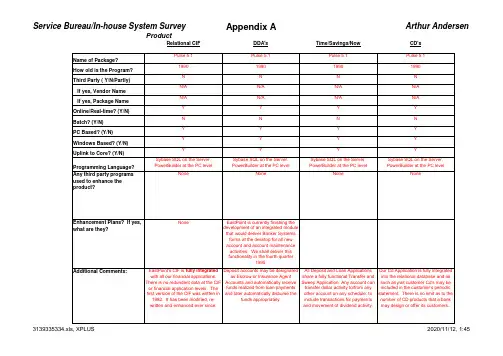
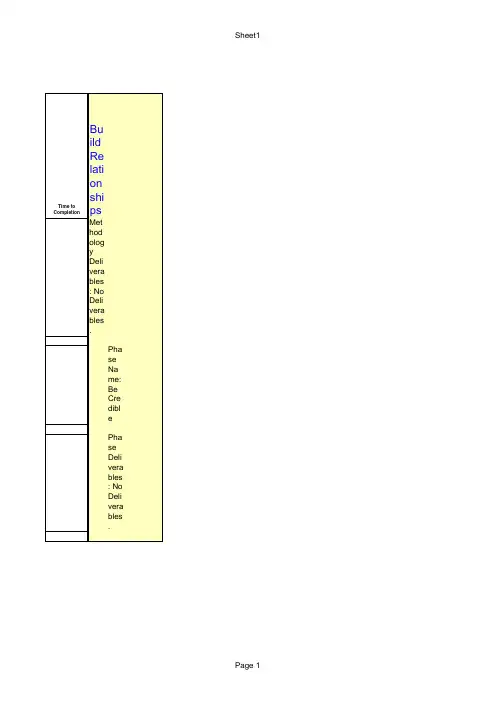
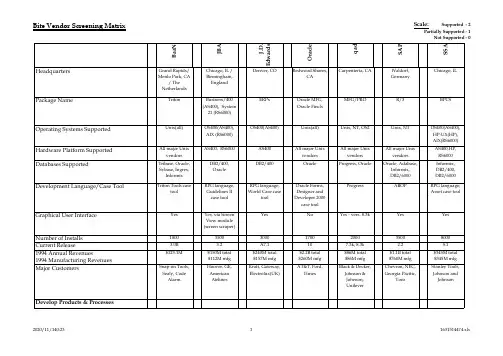
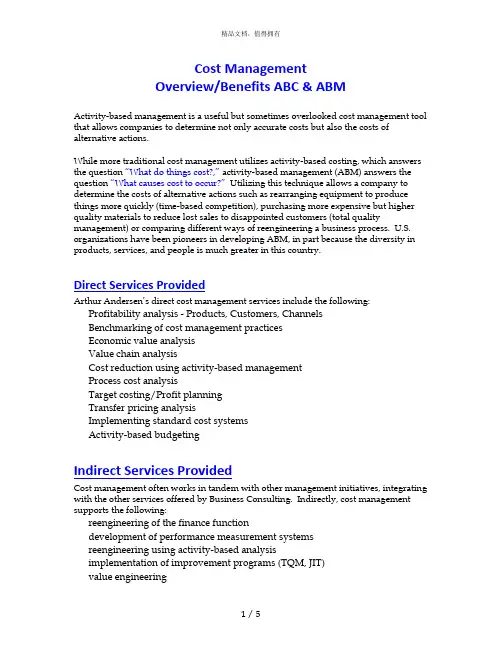
Cost ManagementOverview/Benefits ABC & ABMActivity-based management is a useful but sometimes overlooked cost management tool that allows companies to determine not only accurate costs but also the costs of alternative actions.While more traditional cost management utilizes activity-based costing, which answers the question“What do things cost?,” activity-based management (ABM) answers the question“What causes cost to occur?” Utilizing this technique allows a company to determine the costs of alternative actions such as rearranging equipment to produce things more quickly (time-based competition), purchasing more expensive but higher quality materials to reduce lost sales to disappointed customers (total quality management) or comparing different ways of reengineering a business process. U.S. organizations have been pioneers in developing ABM, in part because the diversity in products, services, and people is much greater in this country.Direct Services ProvidedArthur Andersen’s direct cost manage ment services include the following:☐Profitability analysis - Products, Customers, Channels☐Benchmarking of cost management practices☐Economic value analysis☐Value chain analysis☐Cost reduction using activity-based management☐Process cost analysis☐Target costing/Profit planning☐Transfer pricing analysis☐Implementing standard cost systems☐Activity-based budgetingIndirect Services ProvidedCost management often works in tandem with other management initiatives, integrating with the other services offered by Business Consulting. Indirectly, cost management supports the following:☐reengineering of the finance function☐development of performance measurement systems☐reengineering using activity-based analysis☐implementation of improvement programs (TQM, JIT)☐value engineeringEntry Point/Target Buyer☐CFO; Controller☐Manufacturing☐Telecom☐Utilities☐Services☐Healthcare☐Insurance☐Grocery (ECR)Engagement SizeWhile some pilot jobs are performed for less, the typical engagement size for an entry level cost management engagement if between $100,000 - $300,000. However, a full-scale implementation generally starts at $400,000.Keys to Identifying Opportunities for Cost Reduction ☐High inventories:∙Large central stockroom∙Interactive WIP orders on floor∙Turnover lower than industry average∙WIP turnover exceeds process time∙Piece rate incentive pay∙Productivity measured on per machine/per worker basis☐Long production lead times:∙Functional plant layout, no product focus∙Long distance between work stations∙Large manufacturing lot sizes∙High scrap rate∙Planning lead time exceeds process time∙Bottlenecks at inspection department∙Missed customer delivery dates☐High overhead rates:∙Several forklifts∙Employees walking around, searching for equipment∙Significant handling, storage and inspection costsActivity-Based Cost ManagementOverview & BenefitsActivity-based cost management (ABCM) is the overall practice of activity-based management (ABM), activity-based costing (ABC), and activity-based budgeting (ABB). The uses of ABCM information are numerous. Companies are using ABCM to reengineer operations, improve benchmarking, increase revenues, simplify the budget process, and establish performance measures. Whether implemented alone or as part of a larger performance management system, ABCM provides companies with better information to manage their business. Service Line Questions1. What is the business objective (or problem) being addressed?2. Are current product/service costs accurate?3. What factors contribute most to costs?4. What processes should be improved? Why? How?5. Which products/services are most profitable?6. Do you know which customers are profitable and which are not?7. Which distribution channels are most profitable?6. What departments’ costs appear to be out-of-line? Why?7. Who are the project stakeholders/customers?8. What are their expectations? What is their definition of success?9. What obstacles to change exist? How can they be overcome?What Information Do Activity Based Systems Provide?- Activity cost- Business process costs- Visibility to the root causes of costs- Highlight and assist in focusing on important cost- Reliable cost information about products and servicesActivity-Based ManagementOverview & BenefitsActivity-based management (ABM) is the broad discipline that focuses on achieving customer value and company profit through the management of activities. It draws on activity-based costing (ABC) as a major source of infomation.When we refer to ABC, we are usually describing the use of activity analysis to improve the costing process. It is equally applicable to determining customer costs, channel costs, etc. ABC focuses on determining “what things cost.”Benefits typically derived from ABC include:☐more accurate product costs;☐determination of the costs of services;☐determination of customer costs;☐identification of market or distribution channel costs;☐determination of project costs;☐determination of contract costs;☐determination of what products, customers, or channels to emphasize;☐tracking of direct mail catalog profitability;☐support for measurement of economic value analysis;☐support for contract negotiations;☐support for increasing revenue by helping customers understand their cost reductions through use of your products and services;☐support for target costing;☐support for benchmarking; and☐determination of shared services charge-out amounts.The broader use of activity-based approaches inherent in ABM revolves around using activity-based infor mation to manage operations. ABM focuses more on “how to change and improve your costs.”Benefits typically derived from ABM include:☐identification of redundant costs;☐analysis of value added and non-value added costs;☐quantification of the cost of quality by element;☐identification of customer focused activities;☐analysis of the cost of complexity;☐identification of process costs and support of process analysis;☐measurement of the impact of reengineering efforts;☐better understanding of cost drivers;☐evaluation of manufacturing flexibility investments; andactivity-based budgeting.。
